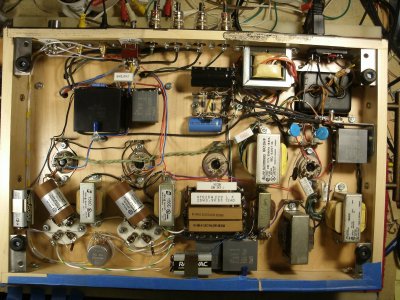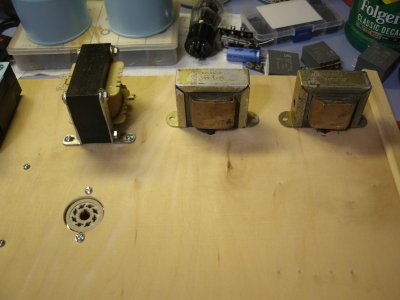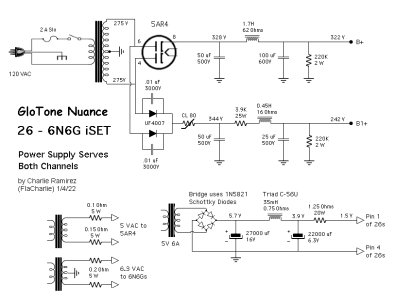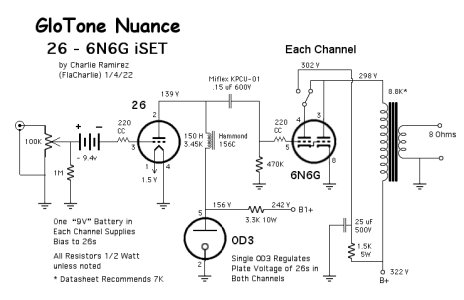FlaCharlie
Member
Thought I'd post a thread about the "inverted" SET ( iSET ) amp that I mentioned in my earlier thread about my Boogie Factor 1626 preamp.
 www.hifivision.com
www.hifivision.com
Most of the discussion about Single Ended Triode amps (and tube amps in general) seems to center on the type of output tube that's being used. Traditionally, the output tubes used in SETs are all directly heated. Many consider direct heating to be the most important ingredient in the whole "SET magic" recipe.
The most commonly used are the 45, 2A3 and 300B as well as some transmitting types. In addition to being directly heated, these tubes share certain characteristics - they are built as triodes (not triode strapped pentodes), relatively difficult to drive and expensive.
Despite the traditional emphasis on output tubes, many people feel that the sonic qualities of the first tube in the signal path is of primary importance. So the use of a directly heated input tube might actually contribute more of that directly heated magic than the output tube.
Directly heated small signal tubes are low mu and can't provide enough drive on their own to drive the DHT output tubes that are most commonly used. So most conventional SETs use indirectly heated input / driver tubes with higher mu, sometimes on their own and sometimes in combination with a DHT input tube. This typically results in a 3 stage amp, sometimes with all three on the amp chassis and sometimes with one stage on a separate preamp chassis.
The "inverted SET" concept uses a configuration which turns tradition on its head. The idea here is to use output tubes that are easy to drive and relatively inexpensive. Most output tubes with those characteristics are indirectly heated. When the output tube is easy to drive, the use of low mu input tubes that are directly heated is more practical. And, instead of 2 gain stages prior to the output tube, a single gain stage design is possible.
So this concept dovetails with the philosophy that simpler designs with a lower parts count produce a more pure outcome. I'm a firm believer in that but perhaps it's just because simple is all I'm capable of understanding. While this amp is pretty basic, I must confess that it could be built even simpler. In the spirit of DIY, a few things were added just because I wanted to try them.
So, with an iSET, the magic of direct heating and its influence on the overall sonic character is still a primary ingredient but it's somewhat simpler and much less expensive to implement.
I'm not very familiar with tubes which were only produced in Europe but no doubt there are some that are easy to drive and suitable. I like to use oddball tubes but I'm also cheap and importing uncommon tubes from Europe can get expensive.
Instead, I chose an oddball output tube that's more readily available in the US, the 6N6G. Definitely an under the radar tube yet not exactly rare or particularly expensive. I used this tube before in a Magnavox 175/185 PP console amp that I modded previously. I'll comment more on the 6N6G later.
Since the iSET concept puts so much emphasis on the input tube, most of my on and off breadboarding (over a period of about 9+ months) was spent trying numerous input triodes and a couple of triode strapped pentodes, which were all directly heated.
While some small signal DHTs are rare and expensive there are quite a few which are relatively common and reasonably priced . . . cheap even. I probably tried at least 10 different types. They all sounded quite nice but the one I kept coming back to was the 26. Of course, these are no longer being produced (as far as I know) yet they seem to be plentiful. Apparently, they were the 12AX7 of the 1930s. As with all of these antique types, the early globe styles are increasingly rare and a more expensive, especially if you insist on buying NOS. The coke bottle shaped ST, not so much. Strong testing used examples of the globe style are still fairly reasonable, though.
One thing I like to do is to use recycled and repurposed parts and materials. For example, the chassis of my Boogie Factor 1626 preamp was built from a bamboo kitchen drawer organizer.
In keeping with that approach, the chassis I used here is a wooden drawer that I picked up at a local store called The Repurpose Project for a few bucks. No handle had ever been attached so it may have never been used. Gold-ish bronze handles ($1 each from the same source) were added to make it easier to move around. The covers for the output transformers and choke came from the grocery store - they're Blue Diamond Almond cans. The rings around the bases of the 26s and 6N6Gs are plastic curtain grommets that I found at a local thrift store for under $1.
I wanted this build to have more visual appeal than my previous builds. You would think that would be easy, since some of them have zero visual appeal. Not sure if I succeeded in terms of "appeal" but it's definitely more colorful than my earlier builds. I was shooting for a kind of 'art deco' color scheme and less of an industrial vibe.
While I had settled on the general theme early on, the cosmetic details took a while to finalize. The bottom of a cheap drawer doesn't get much attention when it comes to fit and finish since it's normally not visible. Of course, this is now the top of the amp so it was painted and I tried to match the trim color to the bronze handles as much as possible.
Here are some pics . . . . starting with an in-progress shot showing the unfinished chassis . . .
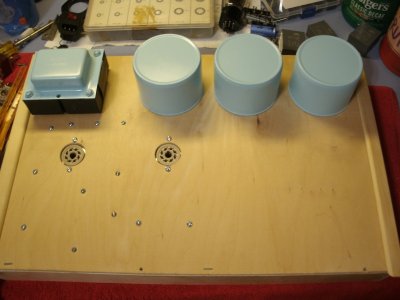
And here's some finished pics . . .
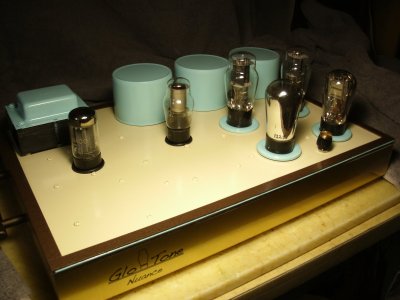
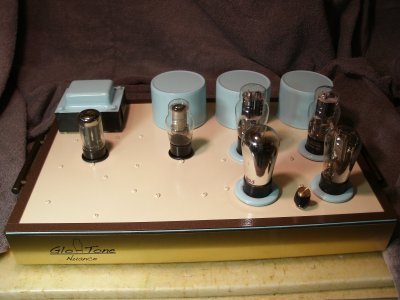
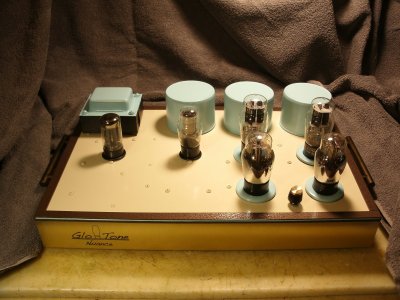
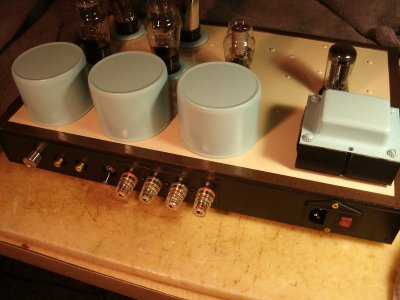
The color in the top (finished) pic is a bit more accurate, it's a little more on the green side of blueish green in person, despite the color being called Gloss Blue Ocean Breeze. The color on the top deck is Navajo White, an off-white that's warm but too yellowish - so not quite cream colored.
Having named my 1626 preamp the Boogie Factor, I thought I'd name this one too. Given the sonic combination of warmth, detail, depth, fluidity and subtlety exhibited by the combination of the 26 and the 6N6G, I decided to name this the Nuance.
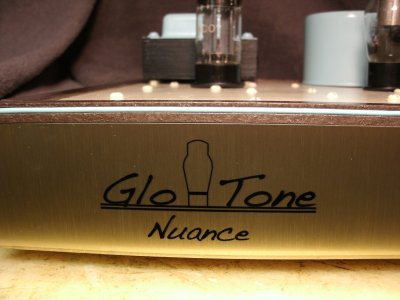
The logo was created with the same ancient Appleworks all-in-one program that I use to draw schematics on an equally ancient Mac Mini. The program can't be run on newer Macs. The original was kind of jaggy so I sent it to a place that "vectorizes" images which cleaned it up enough to be usable. The front plate was created by a local trophy shop.
I'll get into some of the technical aspects and post schematics in another post . . .
Glo-Tone Boogie Factor 1626 Tube Preamp
I mentioned this preamp in the thread about Class D amps and a couple of people seemed interested so this thread will offer some details. What I'll do here is to present an updated version of a thread I posted elsewhere in 2020, when I built this. Some background: I first got interested in...
Most of the discussion about Single Ended Triode amps (and tube amps in general) seems to center on the type of output tube that's being used. Traditionally, the output tubes used in SETs are all directly heated. Many consider direct heating to be the most important ingredient in the whole "SET magic" recipe.
The most commonly used are the 45, 2A3 and 300B as well as some transmitting types. In addition to being directly heated, these tubes share certain characteristics - they are built as triodes (not triode strapped pentodes), relatively difficult to drive and expensive.
Despite the traditional emphasis on output tubes, many people feel that the sonic qualities of the first tube in the signal path is of primary importance. So the use of a directly heated input tube might actually contribute more of that directly heated magic than the output tube.
Directly heated small signal tubes are low mu and can't provide enough drive on their own to drive the DHT output tubes that are most commonly used. So most conventional SETs use indirectly heated input / driver tubes with higher mu, sometimes on their own and sometimes in combination with a DHT input tube. This typically results in a 3 stage amp, sometimes with all three on the amp chassis and sometimes with one stage on a separate preamp chassis.
The "inverted SET" concept uses a configuration which turns tradition on its head. The idea here is to use output tubes that are easy to drive and relatively inexpensive. Most output tubes with those characteristics are indirectly heated. When the output tube is easy to drive, the use of low mu input tubes that are directly heated is more practical. And, instead of 2 gain stages prior to the output tube, a single gain stage design is possible.
So this concept dovetails with the philosophy that simpler designs with a lower parts count produce a more pure outcome. I'm a firm believer in that but perhaps it's just because simple is all I'm capable of understanding. While this amp is pretty basic, I must confess that it could be built even simpler. In the spirit of DIY, a few things were added just because I wanted to try them.
So, with an iSET, the magic of direct heating and its influence on the overall sonic character is still a primary ingredient but it's somewhat simpler and much less expensive to implement.
I'm not very familiar with tubes which were only produced in Europe but no doubt there are some that are easy to drive and suitable. I like to use oddball tubes but I'm also cheap and importing uncommon tubes from Europe can get expensive.
Instead, I chose an oddball output tube that's more readily available in the US, the 6N6G. Definitely an under the radar tube yet not exactly rare or particularly expensive. I used this tube before in a Magnavox 175/185 PP console amp that I modded previously. I'll comment more on the 6N6G later.
Since the iSET concept puts so much emphasis on the input tube, most of my on and off breadboarding (over a period of about 9+ months) was spent trying numerous input triodes and a couple of triode strapped pentodes, which were all directly heated.
While some small signal DHTs are rare and expensive there are quite a few which are relatively common and reasonably priced . . . cheap even. I probably tried at least 10 different types. They all sounded quite nice but the one I kept coming back to was the 26. Of course, these are no longer being produced (as far as I know) yet they seem to be plentiful. Apparently, they were the 12AX7 of the 1930s. As with all of these antique types, the early globe styles are increasingly rare and a more expensive, especially if you insist on buying NOS. The coke bottle shaped ST, not so much. Strong testing used examples of the globe style are still fairly reasonable, though.
One thing I like to do is to use recycled and repurposed parts and materials. For example, the chassis of my Boogie Factor 1626 preamp was built from a bamboo kitchen drawer organizer.
In keeping with that approach, the chassis I used here is a wooden drawer that I picked up at a local store called The Repurpose Project for a few bucks. No handle had ever been attached so it may have never been used. Gold-ish bronze handles ($1 each from the same source) were added to make it easier to move around. The covers for the output transformers and choke came from the grocery store - they're Blue Diamond Almond cans. The rings around the bases of the 26s and 6N6Gs are plastic curtain grommets that I found at a local thrift store for under $1.
I wanted this build to have more visual appeal than my previous builds. You would think that would be easy, since some of them have zero visual appeal. Not sure if I succeeded in terms of "appeal" but it's definitely more colorful than my earlier builds. I was shooting for a kind of 'art deco' color scheme and less of an industrial vibe.
While I had settled on the general theme early on, the cosmetic details took a while to finalize. The bottom of a cheap drawer doesn't get much attention when it comes to fit and finish since it's normally not visible. Of course, this is now the top of the amp so it was painted and I tried to match the trim color to the bronze handles as much as possible.
Here are some pics . . . . starting with an in-progress shot showing the unfinished chassis . . .

And here's some finished pics . . .




The color in the top (finished) pic is a bit more accurate, it's a little more on the green side of blueish green in person, despite the color being called Gloss Blue Ocean Breeze. The color on the top deck is Navajo White, an off-white that's warm but too yellowish - so not quite cream colored.
Having named my 1626 preamp the Boogie Factor, I thought I'd name this one too. Given the sonic combination of warmth, detail, depth, fluidity and subtlety exhibited by the combination of the 26 and the 6N6G, I decided to name this the Nuance.

The logo was created with the same ancient Appleworks all-in-one program that I use to draw schematics on an equally ancient Mac Mini. The program can't be run on newer Macs. The original was kind of jaggy so I sent it to a place that "vectorizes" images which cleaned it up enough to be usable. The front plate was created by a local trophy shop.
I'll get into some of the technical aspects and post schematics in another post . . .
Last edited:


